Key takeaways:
- Post-production is essential for shaping the film’s emotional impact through elements like color grading and sound design.
- Thoughtful pacing and editing can significantly affect storytelling, allowing audiences to absorb pivotal moments.
- Integration of visual effects and sound choices can enhance the narrative without overshadowing it.
- Creative constraints often lead to innovative solutions, pushing filmmakers to adapt and enhance their storytelling techniques.
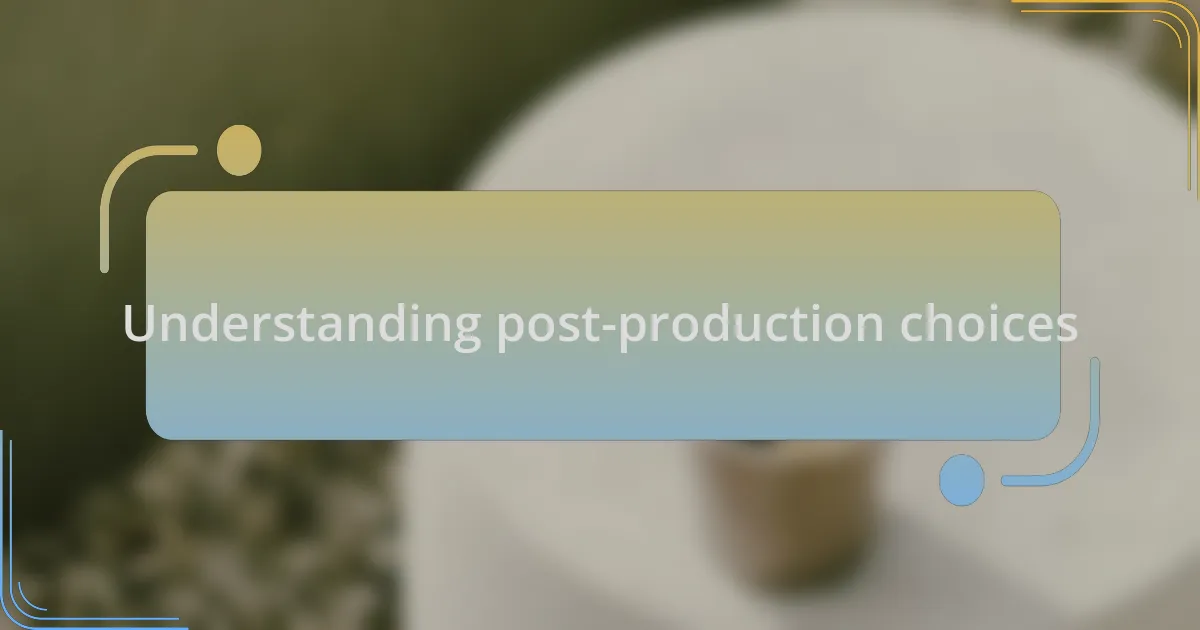
Understanding post-production choices
Post-production choices can often feel overwhelming, but understanding their impact is crucial for shaping the final film. For me, selecting the right color grading can evoke specific emotions that resonate deeply with the audience. I remember a project where a shift to warmer tones during pivotal scenes transformed the viewer’s connection to the characters, enhancing their emotional journey.
As I navigate the editing process, I ask myself what mood I want to create. This kind of self-reflection can pave the way for making choices that speak to the essence of the story. On one occasion, I decided to incorporate jump cuts in a fast-paced sequence to amplify the tension. The result was thrilling! It kept viewers on the edge of their seats, ultimately making the experience more intense and memorable.
Sound design often becomes one of my most impactful post-production choices. I still recall a film where subtle ambient sounds shaped the atmosphere and added an unsettling sense of realism. Isn’t it fascinating how something as simple as a sound can have such a profound effect on the viewer’s experience? Understanding this interaction between sound and visual elements can elevate a film from good to phenomenal.
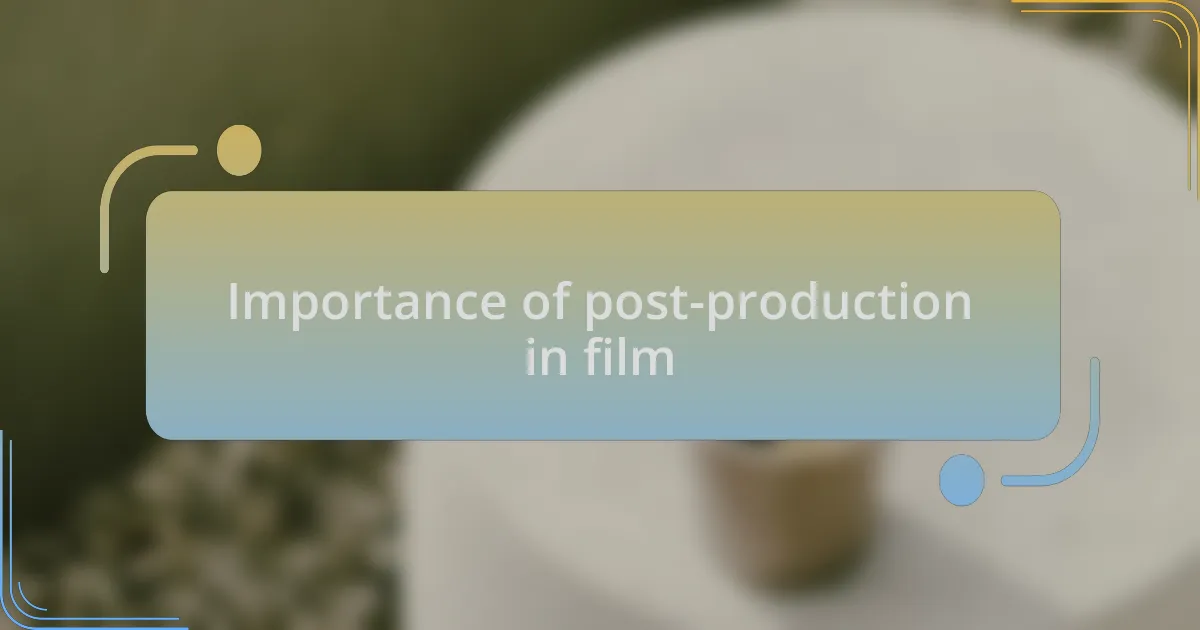
Importance of post-production in film
Post-production isn’t just a technical phase; it’s where the soul of the film emerges. I vividly remember working on a documentary where the editing rhythm directly influenced the storytelling pace. By carefully choosing when to linger on certain shots, I was able to highlight poignant moments that captured the audience’s hearts. Have you ever felt your emotions swell at just the right moment in a film? That’s the power of thoughtful editing.
Another critical aspect of post-production is visual effects. During one project, I was tasked with integrating CGI elements to enhance the story’s fantastical elements. It was a delightful challenge to ensure the effects melded seamlessly with live-action footage, creating a captivating illusion without detracting from the narrative. Isn’t it remarkable how these visual enhancements can transport viewers to another world?
Moreover, the final sound mix can significantly alter a film’s impact. In one project, I decided to use silence strategically—a choice that made certain dialogues feel more powerful. The absence of sound in those moments created a tension that had the audience hanging on every word. Have you noticed how a simple shift in audio can amplify the emotional intensity? That’s the magic of sound in post-production, transforming the viewer’s experience.
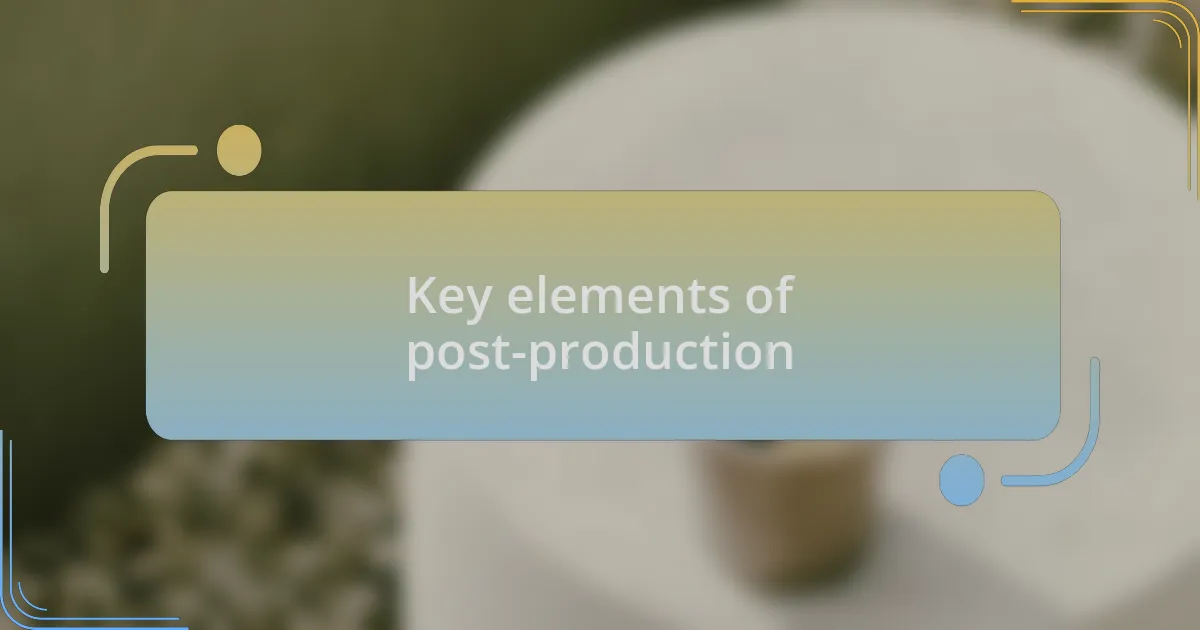
Key elements of post-production
When considering the key elements of post-production, editing stands out as the cornerstone of the process. I recall a project where I experimented with color correction to evoke specific moods throughout the film. By tweaking the hues and contrasts, I was able to guide the audience’s emotional journey—did you ever notice how a subtle shift from warm tones to cooler shades can instantly change how a scene feels? This meticulous attention to detail is what really brings a film to life.
Sound design also plays an integral role in shaping the overall viewing experience. In one instance, I had the opportunity to work with a talented sound designer who created ambient audio layers that felt like characters themselves. The rustling leaves and distant whispers were so meticulously crafted that they elevated the film’s atmosphere. How often do we forget that sound is not just background noise, but a powerful tool for storytelling?
Lastly, I can’t overstate the importance of pacing in post-production. There was a particularly intense scene I worked on, where timing was everything. I found that adjusting the edit to create moments of pause allowed the audience to absorb the weight of what was happening on screen. Have you ever felt that thrill when the pacing perfectly matched your heartbeat? A well-paced film can resonate long after the credits roll.
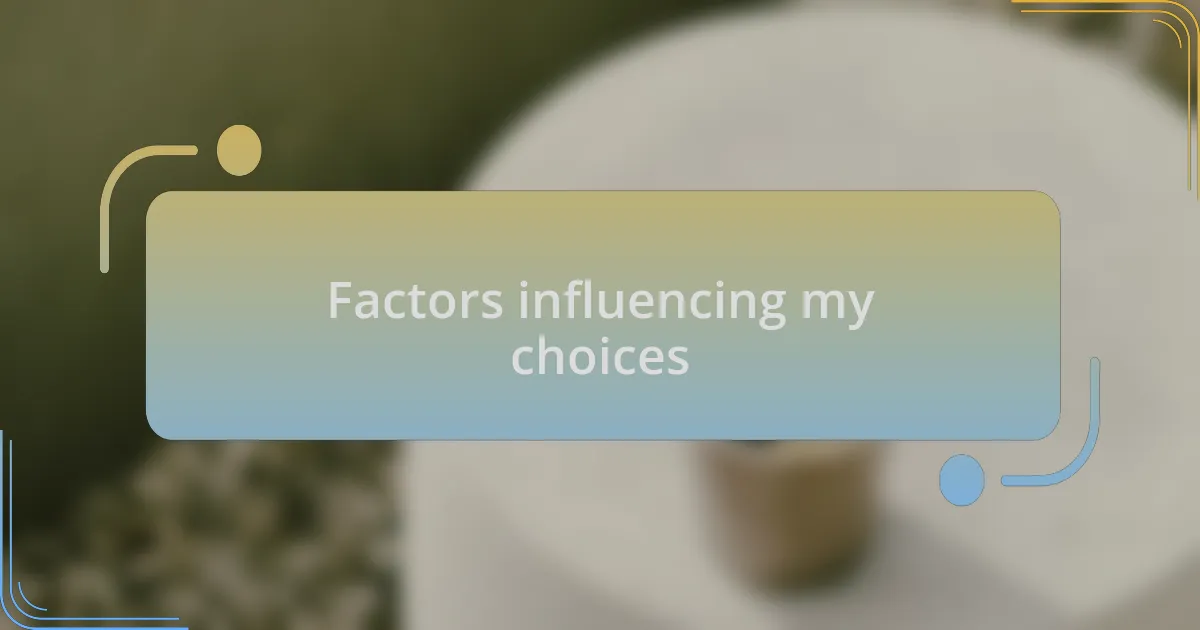
Factors influencing my choices
When I think about the factors influencing my post-production choices, inspiration often comes from the narrative itself. For instance, during a documentary I edited, the emotional arcs of the subjects guided my selection of shots and transitions. It was fascinating to see how a straightforward interview could become deeply moving with a thoughtful choice of music underscoring the heartfelt moments—have you ever felt how a swell of strings can amplify the weight of a story?
I also find that audience expectations play a significant role in my decision-making. While editing a short film intended for festivals, I had to consider the pacing that festival judges typically favor. It became a bit of a balancing act; I had to stay true to the narrative while also keeping the edit snappy enough to maintain attention. This led me to experiment with jump cuts in certain scenes. Did you know that a well-placed jump cut can create a jarring jolt that heightens a moment’s urgency?
Finally, technical constraints often shape my choices as well. I once worked on a project where we had to blend footage shot with different cameras, and it pushed me to get creative with color grading. What I discovered was a unique visual language that not only unified the footage but also deepened the story’s emotional resonance. Have you ever had to adapt your creative vision due to technical limitations? It can be challenging, but sometimes those constraints lead to unexpected artistic breakthroughs.
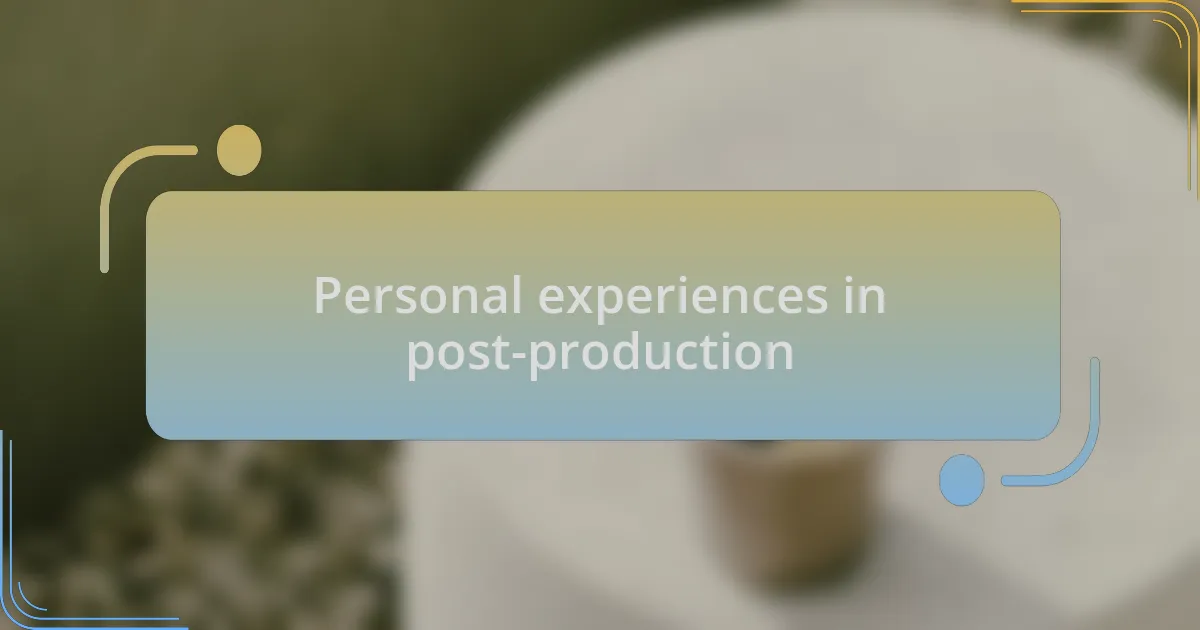
Personal experiences in post-production
As I delved into post-production for my first narrative short, I remember feeling overwhelmed yet exhilarated. Each edit was like piecing together a puzzle—the challenge lay in matching visual rhythm with the character’s emotional journey. I discovered the power of subtle slow-motion shots; they had a way of making the audience pause, giving them space to linger on the character’s feelings. Have you ever felt the tension in the air during a crucial scene when the timing just feels right?
There was another project where sound played a pivotal role in shaping the atmosphere. While editing a horror film, I realized that the absence of sound could be just as impactful as its presence. In post, I experimented with silence, letting it stretch unnervingly, leading up to a sudden, shocking reveal. This experience taught me that sometimes, the quiet moments can scream louder than any roar. What are your thoughts on using silence as a storytelling device?
In a different editing project, I encountered the unique challenge of integrating animated elements into live-action footage. There was a moment when I felt utterly lost, sitting in front of my screen, trying to make two worlds collide seamlessly. It required not only technical knowledge but also a hefty dose of creativity to ensure that both the animation and the live footage felt like they belonged together. Have you ever faced a similar challenge where merging different styles or formats pushed you to rethink your approach? It taught me that embracing discomfort can often lead to the most innovative outcomes.
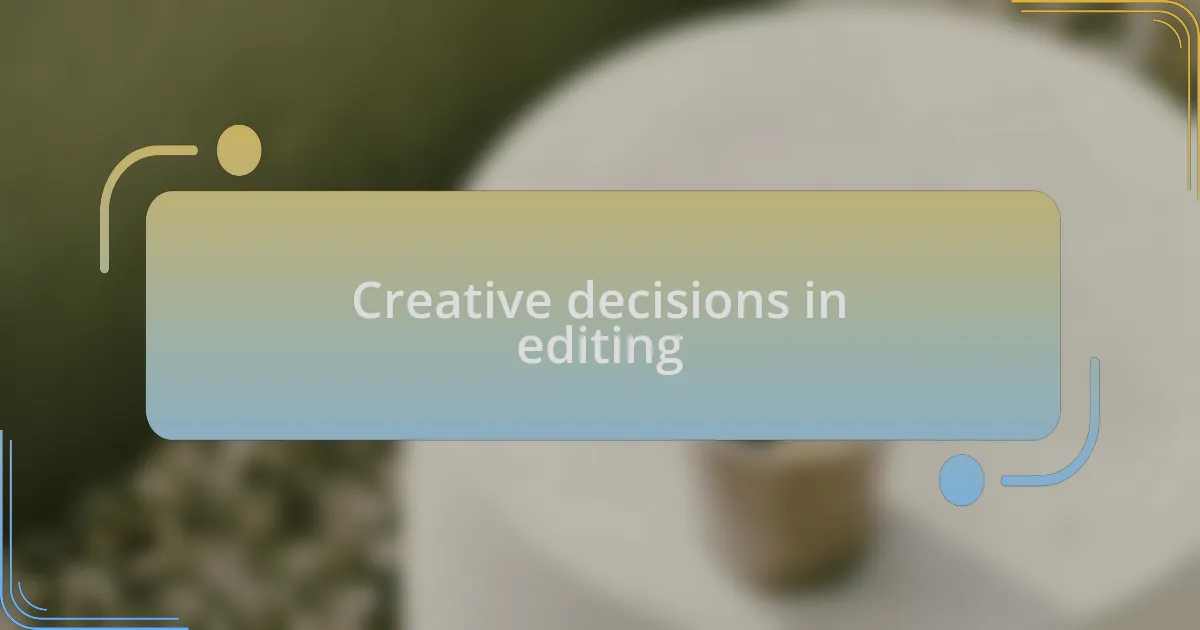
Creative decisions in editing
When I was editing a short documentary, I faced a significant creative decision regarding pacing. I remember watching the footage and feeling a pull between the urgency of the story and the need to let the visuals breathe. After much deliberation, I opted for a slower pace in some sections, allowing the audience to absorb the emotional weight of each moment. Have you ever felt the impact of a well-timed pause in a narrative?
Choosing the right color grade can also be a transformative decision. In one project, I experimented with a warm color palette, which instantly shifted the tone from somber to hopeful. That choice didn’t just tweak the visuals; it altered the entire emotional landscape of the film. I often find myself pondering: how does color influence our emotional responses when we watch a film?
One memorable experience involved structuring a nonlinear narrative during the editing phase. As I arranged various pieces of footage, I felt a rush of excitement at the potential layers of storytelling that emerged. It sparked my creativity in ways I hadn’t anticipated, prompting me to question traditional storytelling methods. Have you ever taken a leap with structure, only to find that it opened up new avenues you hadn’t considered before? That blend of unpredictability and artistry reshaped my perspective on storytelling in film.